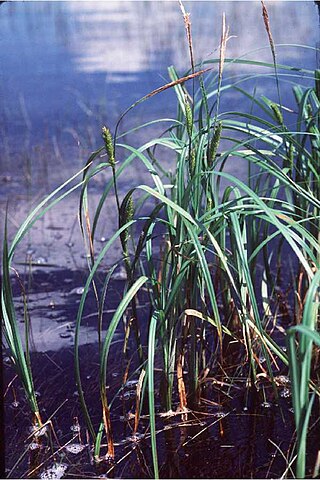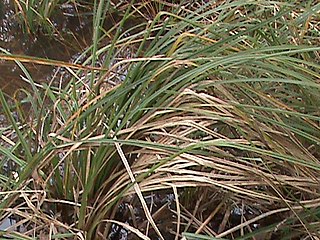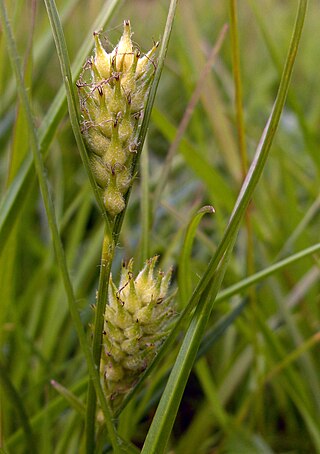
Carex limosa is a species of sedge known as bog-sedge, mud sedge, and shore sedge.

Carex atherodes is a species of sedge known by the common name wheat sedge. It is native to Eurasia and much of North America including most of Canada and the United States. It is a very common wetland plant across the American Midwest and areas west. It grows in moist and wet habitat, such as marshes and moist prairie land, and it may grow in shallow water. This sedge produces triangular, hollow stems 30 to 120 centimeters tall. The leaves are hairy, especially on the lower parts, and the leaf sheath is tinted with reddish purple. The inflorescence is up to 60 centimeters long and made up of several spikes; those spikes near the tip are usually staminate, and those lower in the inflorescence are usually pistillate. The tip of each fruit has two or more long, thin teeth.

Carex barbarae is a species of sedge known as Santa Barbara sedge.

Carex concinnoides is a species of sedge known by the common name northwestern sedge. It is native to western North America from British Columbia to California, where it can be found in moist or dry habitat, often in woodland and forested slopes, on silty and clay soils. This sedge produces loose clumps of stems up to about 35 centimeters in maximum height from long rhizomes. The leaves are thick but narrow, sickle-shaped, and pale green in color. Inflorescences occur at the stem tips, and some pistillate inflorescences grow from nodes along the stem. The spikelets have purplish bracts. The pistillate flowers have four stigmas on each pistil, an identifying characteristic. The fruit is coated in a sac called a perigynium, which is white to light brown in color, purple-tipped, and covered in hairs.

Carex filifolia is a species of sedge known by the common name threadleaf sedge. It is native to western North America and grows on slopes, eroded areas, gravel, and dry habitats.

Carex hoodii is a species of sedge known by the common name Hood's sedge. It is native to western North America from Alaska to Nunavut to California to South Dakota, where it grows in dry to moist habitat in forests and on mountain slopes.

Carex praegracilis is a species of North American sedge known as clustered field sedge, field sedge, and expressway sedge. Carex praegracilis is cultivated in the specialty horticulture trade as lawn substitute and meadow-like plantings.
Carex sheldonii is a species of sedge known by the common name Sheldon's sedge.
Carex klamathensis is a rare species of sedge known by the common name Klamath sedge. It is known from 15 or fewer populations in southern Oregon and three populations in the Klamath Region of northern California. It was described to science only in 2007. Its habitat includes fens and other wet habitat, on serpentine soils. It was discovered independently by botanists Peter Zika and Lawrence Janeway.

Carex hirta, the hairy sedge or hammer sedge, is a species of sedge native across Europe. It has characteristic hairy leaves and inflorescences, and is the type species of the genus Carex.

Carex binervis, the green-ribbed sedge, is a European species of sedge with an Atlantic distribution. It is found from Fennoscandia to the Iberian Peninsula, and occurs in heaths, moorland and other damp, acidic environments. It typically grows to a height of 15–120 cm (6–50 in), and has inflorescences comprising one male and several female spikes, each up to 45 mm (1.8 in) long. The utricles have two conspicuous green veins, which give rise to both the scientific name and the common name of the species. In the vegetative state, it closely resembles C. bigelowii, a species that usually grows at higher altitude. C. binervis was first described by James Edward Smith in 1800, and is classified in Carex sect. Spirostachyae; several hybrids with other Carex species are known.

Carex lacustris, known as lake sedge, is a tufted grass-like perennial of the sedge family (Cyperaceae), native to southern Canada and the northern United States. C. lacustris us an herbaceous surface-piercing plant that grows in water up to 50 cm (1.6 ft) deep, and grows 50–150 cm (1.6–4.9 ft) tall. It grows well in marshes and swampy woods of the boreal forest, along river and lake shores, in ditches, marshes, swamps, and other wetland habitat. It grows on muck, sedge peat, wet sand or silt, in filtered or full sunlight.

Carex rosea, the rosy sedge, is a flowering plant and part of the family Cyperaceae. Synonyms for Carex rosea include Carex concoluta, and Carex flaccidula. It is native to central and eastern North America and it exists in wet to dry soils. Carex rosea can be found in shores of streams and bottomlands, as well as ponds. It is known to have good adaptations to dry-shade locations. It is an evergreen plant which is easy to grow.
Actinoschoenus arthrostyloides, commonly known as hairy actinoschoenus, is flowering plant in the sedge family, Cyperaceae, that is native to Western Australia throughout parts of the Kimberley region.

Eleocharis ochrostachys, commonly known as spike rush, is a sedge of the family Cyperaceae that is native to Australia and Asia.

Carex davisii, known as Davis' sedge or awned graceful sedge, is a species of Carex native to North America. It is listed as an endangered, threatened, or species of concern across much of edge of its range. It was named in the 1820s by Lewis David de Schweinitz and John Torrey in honor of Emerson Davis (1798–1866), a Massachusetts educator and "enthusiastic student of the genus" Carex.

Carex brevior, known as shortbeak sedge and plains oval sedge, is a species of sedge native to North America. The specific epithet brevior means "shorter" in Latin.

Carpha alpina, commonly known as small flower-rush, is a tufted perennial sedge from the family Cyperaceae. It is found primarily in south-east Australia and both islands of New Zealand, but also in Papua New Guinea.

Carex bicolor, the bicoloured sedge, is a species of sedge native to North America, Northern Europe and Northern Asia. The International Union for Conservation of Nature has assessed the plant's conservation status as being of least concern because it has a widespread distribution and faces no particular threats.

Carex baileyi is a sedge in section Vesicariae the genus Carex native to the Appalachian mountains in Eastern North America. It is commonly called Bailey's sedge. Carex baileyi was named in honor of Liberty Hyde Bailey by its discoverer, Nathaniel_Lord_Britton.

















